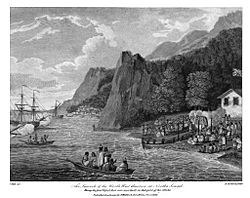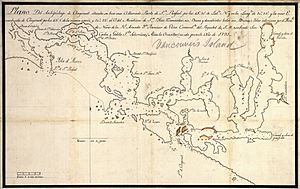North West America facts for kids
Quick facts for kids History |
|
|---|---|
| Name | North West America |
| Launched | 1788 |
| Captured | By Spanish Navy, 1789 |
| Name | Santa Gertrudis la Magna and, later, Santa Saturnina |
| Acquired | 1789 |
| General characteristics | |
| Tons burthen | About 30–50 tons (bm) |
| Length | 33 ft (10 m) |
| Propulsion | Sails and 8 oars |
| Sail plan | Schooner |
The North West America was a British merchant ship. It sailed on fur trading trips in the late 1780s. This ship was special because it was the first non-native vessel built in the Pacific Northwest.
In 1789, the ship was captured by Esteban José Martínez of Spain. This happened at Nootka Sound during a disagreement called the Nootka Crisis. After being captured, it became part of the Spanish Navy. Its name was changed first to Santa Gertrudis la Magna and then to Santa Saturnina.
The ship was very important for both British and Spanish explorers. It helped them map the Pacific Northwest. This included areas like the Strait of Juan de Fuca, the San Juan Islands, and the Strait of Georgia. Under Spanish commander José María Narváez, the Santa Saturnina was the first European ship to explore the Strait of Georgia. It also explored the area where the city of Vancouver is today.
The vessel was a type of ship called a schooner. The Spanish called it a goleta. Its exact size is not fully known. Some thought it was about 40 to 50 tons. Others estimated it at about 30 tons. When it became Santa Saturnina, it might have been made bigger. It was about 33 feet long and could use sails or eight oars.
Contents
Building the North West America
The North West America was built at Nootka Sound on Vancouver Island in 1788. Materials for the ship came from Asia. They were carried on two other ships, the Felice Adventurer and the Iphigenia Nubiana. These ships had sailed from Macau in January 1788.
John Meares, a captain, wanted to set up a fur trading post at Nootka Sound. So, he brought materials to build a ship and a house. Fifty Chinese men were hired to help with the building. They were the first Chinese people known to visit the Pacific Northwest and Hawaii.
Meares did not have the proper licenses from British companies. To hide this, he used the flag of Portugal. The North West America also flew the Portuguese flag after it was built.
The ship was launched on September 20, 1788. It was the first non-native ship built in this region. Robert Funter became its commander. Soon after, Meares sailed back to Macau. The Iphigenia and North West America were towed out of Nootka Sound. They then sailed to the Hawaiian Islands for the winter.
They arrived at Maui in December 1788. Then they went to Hawaii and anchored in Kealakekua Bay. This was the first time European ships had visited Kealakekua Bay since Captain James Cook was killed there in 1779. On December 10, the future king of the Hawaiian Kingdom, Kamehameha I, visited the two ships.
Over the winter, the ships sailed between islands. In March 1789, they sailed back to Nootka Sound. They hoped to meet Meares there. The Iphigenia arrived on April 20, 1789. The North West America arrived on April 24, after a fur trading trip. Both ships needed repairs.
Meanwhile, Meares's company joined with another British company. The new company had proper licenses. So, their ships sailing to Nootka Sound in 1789 flew the British flag. The Iphigenia and North West America were now under the command of James Colnett.
The Nootka Incident
Before Colnett's ships arrived, the North West America was ready to sail again. Funter left Nootka Sound on April 28, 1789, for a trading trip. Two days later, Robert Gray left with his ship, the Lady Washington.
Only the Iphigenia and the Columbia Rediviva were left at Nootka Sound. On May 6, 1789, a Spanish warship, the Princesa, arrived. It was commanded by Esteban José Martínez. Spain wanted to build an outpost and claim the area.
On May 12, another Spanish ship arrived. Martínez then arrested Captain Douglas and seized the Iphigenia. This was the start of the Nootka Crisis, a big international problem.
After talks, Martínez released Douglas and the Iphigenia. Douglas left Nootka Sound on June 1, 1789. He hoped to meet Funter on the North West America, but they missed each other. On June 8, Funter sailed the North West America into Nootka Sound. Funter and his crew were arrested, and the North West America was seized.
The North West America was never returned to the British. It became a Spanish ship. It was renamed Santa Gertrudis la Magna and later Santa Saturnina.
On June 21, 1789, Martínez sent José María Narváez to explore. Narváez was in command of the captured North West America, now called Santa Gertrudis la Magna. He explored inlets south of Nootka Sound.
By early July, Narváez returned. He had sailed about 65 miles (105 km) into the Strait of Juan de Fuca. This showed it was a very large inlet. He also visited the Makah village at Neah Bay. This was the first time a Spaniard had done so.
Martínez thought the Strait of Juan de Fuca was the entrance to the legendary Northwest Passage. This made it very important. So, he sent two ships, the San Carlos and the captured Princess Royal, to a Spanish naval base. They carried news about the strait. In October, Martínez left Nootka Sound and returned to the base with his prisoners and captured ships.
Spanish records about Santa Gertrudis la Magna can be confusing. This is partly because another Spanish warship with a similar name was also in use. Sometime before early 1791, Santa Gertrudis la Magna (the former North West America) was renamed Santa Saturnina.
On May 4, 1791, an exploration trip began from Nootka Sound. Francisco de Eliza commanded the San Carlos. The Santa Saturnina was commanded by José María Narváez. Other important people on the trip included Juan Pantoja y Arriaga and Juan Carrasco.
Eliza was told to explore Bucareli Bay in Alaska and the Strait of Juan de Fuca. The expedition sailed north from Nootka Sound. But strong winds slowed the Santa Saturnina. So, Eliza decided to turn south towards Clayoquot Sound instead.
Narváez took the Santa Saturnina to explore Clayoquot Sound and Barkley Sound. He spent about two weeks mapping the area. In Barkley Sound, the Santa Saturnina was attacked twice by groups of about 200 Nuu-chah-nulth people. Narváez used cannon fire to keep them away. He said the natives had never seen a Western ship inside Barkley Sound before.
From Barkley Sound, Narváez took the Santa Saturnina to meet Eliza. They met at Esquimalt Harbour, which the Spanish called Cordova. Narváez arrived there on June 11, 1791.
Eliza then had Juan Pantoja y Arriaga, helped by Narváez, Carrasco, and Verdía, explore Haro Strait. They used the Santa Saturnina and a longboat. Pantoja entered the strait on June 14. He sailed along the shores of San Juan Island, Pender Island, and Saturna Island. Then he entered the open waters of the Strait of Georgia. He named it Canal de Nuestra Señora del Rosario. He continued east, reaching Rosario Strait and Lummi Island. Then he returned to Esquimalt.
Eliza moved his base to Puerto de Quadra (today Port Discovery). This was on the southern side of the Strait of Juan de Fuca. On July 1, Narváez took the Santa Saturnina and the longboat to explore Rosario Strait. Carrasco was the pilot.
Narváez sailed through the strait, calling it Canal de Fidalgo. He surveyed Guemes Island, Cypress Island, and Lummi Island. He explored Padilla Bay and Bellingham Bay. He anchored in Chuckanut Bay before heading north into the Strait of Georgia. He anchored in Birch Bay and Drayton Harbor. He also sailed west around Point Roberts.
From there, Narváez took the Santa Saturnina far north into the Strait of Georgia. They were the first Europeans to do this. He made a rough map of the coast. This included Point Roberts, Point Grey (part of Vancouver today), Burrard Inlet, and several islands. He returned to Port Discovery in late July.
Near Point Grey, Narváez noticed a lot of fresh water. He correctly guessed that a large river was nearby—the Fraser River. He also saw many whales in the Strait of Georgia. This made Eliza think there was another way to the open ocean. It also suggested that Nootka Sound was on an island, which it is.
Many of Eliza's sailors were sick. So, he decided to return to Nootka Sound. He moved Narváez to his main ship, the San Carlos. He gave command of the Santa Saturnina to Juan Carrasco. The two ships sailed out of the Strait of Juan de Fuca together. They found and named Port Angeles Harbor along the way. On August 7, they arrived at Neah Bay.
From there, the San Carlos sailed north to Nootka Sound. Carrasco could not sail the Santa Saturnina against the wind to Nootka. So, he sailed south to Monterey and then to San Blas. In Monterey, he met the Malaspina Expedition. This expedition then learned about the Strait of Georgia. They arranged for two of their officers to explore it more in 1792.
What Happened to the Ship?
The final fate of the Santa Saturnina is not fully known. It seems it became part of the small Spanish fleet based at San Blas. This fleet mostly supplied the Spanish missions in California. In 1792, the Santa Saturnina, still commanded by Juan Carrasco, sailed from San Blas to San Francisco. From there, Carrasco sailed to Monterey. He met with Bodega y Quadra to discuss talks with George Vancouver about the Nootka Crisis. After this, details about the Santa Saturnina are unknown.



